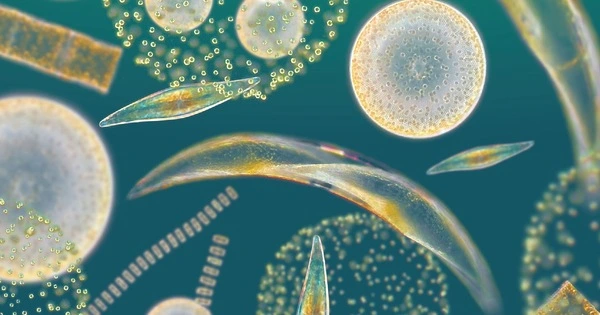Phytoplankton are microscopic organisms that live in the upper layers of oceans, seas, and lakes of freshwater. These are the plankton’s autotrophic (self-feeding) components, and they play an important role in both ocean and freshwater ecosystems. They are primary producers in aquatic habitats, which means they use photosynthesis to synthesize organic molecules and generate oxygen. The name is derived from Greek terms φυτόv (phyton), meaning ‘plant’, and (planktos), meaning ‘wanderer’ or ‘drifter’.
Phytoplankton is extremely diverse, consisting of several forms of algae, protists, and cyanobacteria. These microscopic organisms serve an important part in the marine food web, acting as the foundation of the food chain. They are ingested by zooplankton, which are then eaten by larger creatures like fish, crabs, and marine mammals. Phytoplankton also contributes to the global carbon cycle by absorbing CO2 during photosynthesis, which helps to regulate Earth’s climate.
Phytoplankton receive energy through photosynthesis, same like trees and other plants on land. This means that phytoplankton requires sunlight and so lives in the well-lit surface layers (euphotic zone) of oceans and lakes. In comparison to terrestrial plants, phytoplankton are dispersed across a larger surface area, are subject to less seasonal change, and have far higher turnover rates than trees. As a result, phytoplankton reacts quickly on a global scale to climate change.
Phytoplankton constitute the foundation of marine and freshwater food webs and play an important role in the global carbon cycle. They account for over half of worldwide photosynthetic activity and at least half of oxygen production, although comprising just approximately 1% of global plant biomass. Phytoplankton is extremely diverse, ranging from photosynthesizing bacteria to plant-like algae to armor-plated coccolithophores. Diatoms, cyanobacteria, and dinoflagellates are among the most important phytoplankton groups, but there are many others.
Furthermore, phytoplankton are susceptible to variations in environmental factors such as temperature, nutrition availability, and light intensity. Monitoring their number and distribution can reveal important information about the health of marine ecosystems and the impact of climate change. Phytoplankton blooms, or rapid increases in phytoplankton populations, can occur under particular conditions and have both good and negative effects on marine ecosystems and human activities.
















